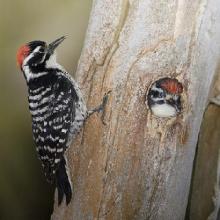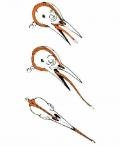When a woodpecker bores a hole into a hard tree trunk, it pecks the tree with its beak twenty times a second. The impact of a single peck is equivalent to slamming into a wall headfirst at 25km an hour. Yet woodpeckers never suffer from headaches or concussions. Why not? The secret lies in the structure of their heads and in the way they peck. Woodpeckers’ brains are protected from shock by a triple layer of cushioning. The muscles that develop at the base of the beak, along with the sponge-like material inside the large, thick cranium, absorb the shock to the woodpecker’s head. Furthermore, the base of the woodpecker’s long tongue is in the back of its head, and it wraps around the skull forming a cushion to protect the brain. When a woodpecker pecks a tree it uses its feet gripping the tree trunk as a fulcrum, and by the law of the lever it uses its entire body as a hammer to swing its beak down. Its thick tail feathers act as both a brace to anchor its body and a spring to increase the momentum of its descending beak. The beak strikes perpendicularly to the tree, which also helps to reduce shock to the brain. This is the same principle at work with heading in soccer, where hitting the ball with the proper spot on the forehead causes no shock to the head. The triple head guard and skillful full-body pecking motion allows the woodpecker to protect its brain from vibration and impact.
- Defense/Stability:
- Shock resistance
Bike helmets with shock absorbing sponge on the inside were developed based on the woodpecker’s head structure. There are also new ice picks for mountain climbing on the market that imitate the shape and function of the woodpecker’s body and feature a gently curved handle.
- Bike helmets, ice picks for mountain climbing.
Machines like jackhammers or drills that are used on construction sites put heavy strain on their operators due to the vibrations and high impact. The woodpecker’s mechanism for absorbing vibration and impact can be used to develop new machines that are safer and less burdensome. It can also be applied to things like canes, ice axes used in mountain climbing, and the construction of buildings that absorb earthquake tremors.



















